The Utrasound Doppler Market is estimated to be valued at USD 3.0 billion in 2025 and is projected to reach USD 4.5 billion by 2035, registering a compound annual growth rate (CAGR) of 4.3% over the forecast period.
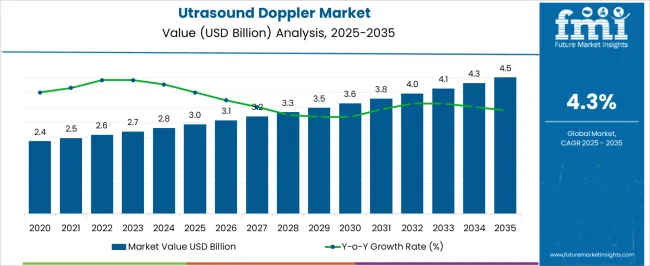
| Metric | Value |
|---|---|
| Utrasound Doppler Market Estimated Value in (2025 E) | USD 3.0 billion |
| Utrasound Doppler Market Forecast Value in (2035 F) | USD 4.5 billion |
| Forecast CAGR (2025 to 2035) | 4.3% |
The ultrasound Doppler market is experiencing significant growth driven by increasing demand for non-invasive diagnostic imaging solutions across cardiovascular and vascular applications. Rising prevalence of cardiovascular diseases, coupled with the need for early detection and continuous patient monitoring, is driving adoption in hospitals and specialized clinics worldwide. Technological advancements in Doppler ultrasound devices, including improved imaging resolution, portability, and integration with hospital information systems, are enhancing diagnostic accuracy and operational efficiency.
Investments in healthcare infrastructure, particularly in emerging markets, are further supporting market expansion. The growing focus on minimally invasive procedures and patient safety is promoting the use of advanced ultrasound solutions as alternatives to traditional imaging techniques.
In addition, rising awareness among healthcare professionals about early detection benefits, combined with increasing government initiatives to improve cardiovascular health, is shaping the market trajectory With continuous innovation in device portability, automation, and real-time analytics, the ultrasound Doppler market is poised to maintain strong growth through the forecast period, driven by the integration of imaging technology into routine clinical workflows.
The utrasound doppler market is segmented by type, application, end-use, and geographic regions. By type, utrasound doppler market is divided into Trolley-Based and Handheld. In terms of application, utrasound doppler market is classified into Cardiology, Radiology, Obstetrics And Gynecology, and Others. Based on end-use, utrasound doppler market is segmented into Hospitals, Diagnostic Imaging Centers, Home Care, and Academic & Research Institutes. Regionally, the utrasound doppler industry is classified into North America, Latin America, Western Europe, Eastern Europe, Balkan & Baltic Countries, Russia & Belarus, Central Asia, East Asia, South Asia & Pacific, and the Middle East & Africa.
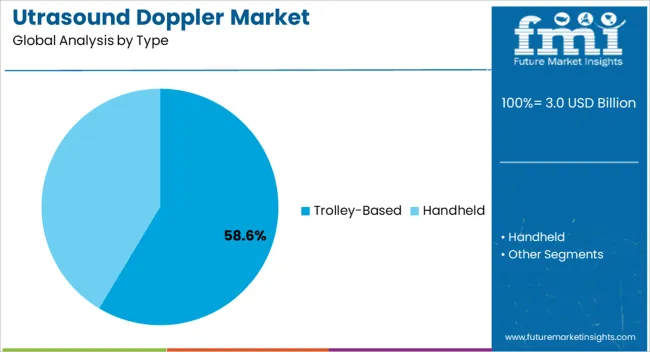
The trolley-based segment is projected to hold 58.6% of the ultrasound Doppler market revenue share in 2025, establishing it as the leading type. Its dominance is being supported by the segment’s ability to provide stable, high-performance imaging while remaining portable within hospital settings. Trolley-based systems facilitate easy movement between departments and are compatible with multiple applications, enhancing operational efficiency.
The availability of larger displays, advanced processing units, and modular add-ons in trolley-based devices improves diagnostic precision and workflow flexibility. Hospitals and diagnostic centers are increasingly adopting this type due to its robustness, reliability, and capacity to support multiple imaging modalities simultaneously.
The ability to integrate Doppler imaging with other diagnostic tools in a single platform further strengthens adoption As healthcare facilities continue to prioritize patient throughput and operational efficiency, trolley-based ultrasound Doppler systems are expected to maintain their leading market position, driven by ongoing technological enhancements and widespread acceptance in clinical environments.
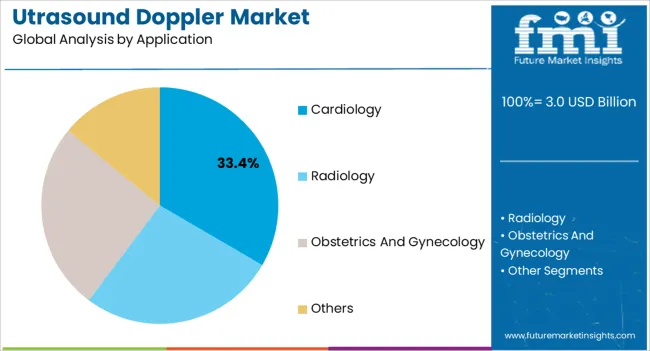
The cardiology application segment is anticipated to account for 33.4% of the ultrasound Doppler market revenue share in 2025, positioning it as the leading application. This growth is being driven by the increasing prevalence of cardiovascular disorders and the rising need for early detection of heart-related conditions. Doppler ultrasound provides non-invasive, real-time imaging of blood flow and heart structures, facilitating accurate diagnosis, treatment planning, and monitoring of cardiac patients.
The segment is further supported by the increasing integration of Doppler devices into routine cardiac assessments in hospitals and outpatient clinics. Continuous advancements in imaging resolution, portable designs, and AI-assisted analysis are improving diagnostic efficiency and patient outcomes.
Regulatory emphasis on preventive healthcare and cardiovascular screening programs is also contributing to the adoption of cardiology-focused Doppler systems As healthcare providers aim to enhance early intervention strategies and reduce complications associated with heart diseases, the cardiology application segment is expected to remain a dominant contributor to the market.
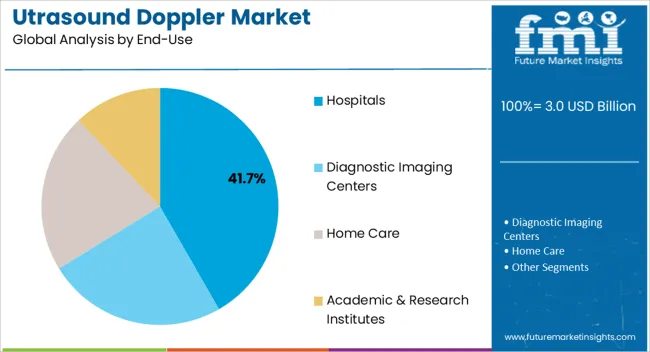
The hospitals end-use segment is expected to hold 41.7% of the ultrasound Doppler market revenue share in 2025, making it the leading end-use category. This dominance is being driven by the widespread adoption of Doppler ultrasound systems in hospital settings for comprehensive diagnostic applications. Hospitals benefit from high-performance devices that offer real-time imaging for multiple patient types and applications, including cardiology, vascular studies, and critical care monitoring.
The integration of advanced features such as high-resolution imaging, portable trolley-based units, and connectivity with electronic health records enhances workflow efficiency and patient care quality. Additionally, hospitals are increasingly investing in devices that support non-invasive, repeatable diagnostics to improve patient safety and reduce procedure times.
The growing prevalence of chronic diseases, coupled with expanding hospital infrastructure in both developed and emerging markets, is sustaining demand Continuous improvements in device accuracy, portability, and ease of use are expected to reinforce the hospital segment’s leadership position in the ultrasound Doppler market through the forecast period.
The term ‘ultrasound treatment’ is a known one, while some of us may even have undergone some kind of check-up with its assistance. As the name suggests, a Doppler Ultrasound test uses higher frequency sound waves to measure blood flow in the arteries and veins and is usually done on the arms and legs.
It is a completely risk and pain free procedure as it only involves using high intensity sound waves. It is recommended by doctors to check for signs of deep vein thrombosis, superficial thrombophlebitis, arteriosclerosis or even if tumours are suspected in any of the limbs.
The ultrasound Doppler market can broadly be classified into two main types based on portability- handheld and trolley based ones. The trolley based ones account for the majority sold at present but the handheld ones are expected to show larger growth because of ease of use, cheaper initial expenditure and also lower long term cost of running due to less electricity consumed as compared to trolleys.
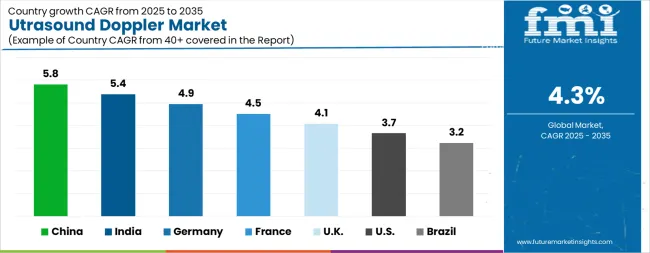
| Country | CAGR |
|---|---|
| China | 5.8% |
| India | 5.4% |
| Germany | 4.9% |
| France | 4.5% |
| UK | 4.1% |
| USA | 3.7% |
| Brazil | 3.2% |
The Utrasound Doppler Market is expected to register a CAGR of 4.3% during the forecast period, exhibiting varied country level momentum. China leads with the highest CAGR of 5.8%, followed by India at 5.4%. Developed markets such as Germany, France, and the UK continue to expand steadily, while the USA is likely to grow at consistent rates. Brazil posts the lowest CAGR at 3.2%, yet still underscores a broadly positive trajectory for the global Utrasound Doppler Market. In 2024, Germany held a dominant revenue in the Western Europe market and is expected to grow with a CAGR of 4.9%. The USA Utrasound Doppler Market is estimated to be valued at USD 1.1 billion in 2025 and is anticipated to reach a valuation of USD 1.5 billion by 2035. Sales are projected to rise at a CAGR of 3.7% over the forecast period between 2025 and 2035. While Japan and South Korea markets are estimated to be valued at USD 139.2 million and USD 79.5 million respectively in 2025.
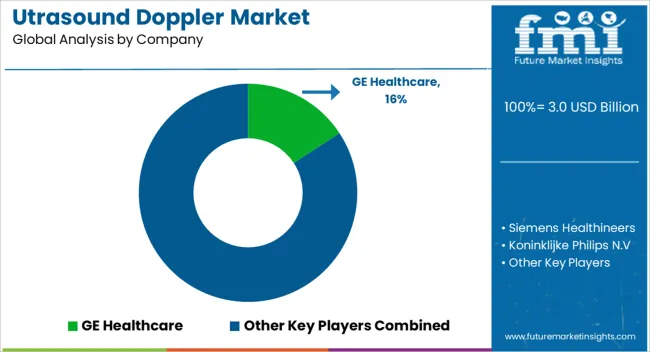
| Item | Value |
|---|---|
| Quantitative Units | USD 3.0 Billion |
| Type | Trolley-Based and Handheld |
| Application | Cardiology, Radiology, Obstetrics And Gynecology, and Others |
| End-Use | Hospitals, Diagnostic Imaging Centers, Home Care, and Academic & Research Institutes |
| Regions Covered | North America, Europe, Asia-Pacific, Latin America, Middle East & Africa |
| Country Covered | United States, Canada, Germany, France, United Kingdom, China, Japan, India, Brazil, South Africa |
| Key Companies Profiled | GE Healthcare, Siemens Healthineers, Koninklijke Philips N.V, Toshiba Medical Systems Corporation, Fujifilm Holdings Corporation, Hitachi Ltd., Esaote SpA, Samsung Medison Co., Ltd, Mindray Medical International Limited, and Analogic Corporation |
The global utrasound doppler market is estimated to be valued at USD 3.0 billion in 2025.
The market size for the utrasound doppler market is projected to reach USD 4.5 billion by 2035.
The utrasound doppler market is expected to grow at a 4.3% CAGR between 2025 and 2035.
The key product types in utrasound doppler market are trolley-based and handheld.
In terms of application, cardiology segment to command 33.4% share in the utrasound doppler market in 2025.






Our Research Products

The "Full Research Suite" delivers actionable market intel, deep dives on markets or technologies, so clients act faster, cut risk, and unlock growth.

The Leaderboard benchmarks and ranks top vendors, classifying them as Established Leaders, Leading Challengers, or Disruptors & Challengers.

Locates where complements amplify value and substitutes erode it, forecasting net impact by horizon

We deliver granular, decision-grade intel: market sizing, 5-year forecasts, pricing, adoption, usage, revenue, and operational KPIs—plus competitor tracking, regulation, and value chains—across 60 countries broadly.

Spot the shifts before they hit your P&L. We track inflection points, adoption curves, pricing moves, and ecosystem plays to show where demand is heading, why it is changing, and what to do next across high-growth markets and disruptive tech

Real-time reads of user behavior. We track shifting priorities, perceptions of today’s and next-gen services, and provider experience, then pace how fast tech moves from trial to adoption, blending buyer, consumer, and channel inputs with social signals (#WhySwitch, #UX).

Partner with our analyst team to build a custom report designed around your business priorities. From analysing market trends to assessing competitors or crafting bespoke datasets, we tailor insights to your needs.
Supplier Intelligence
Discovery & Profiling
Capacity & Footprint
Performance & Risk
Compliance & Governance
Commercial Readiness
Who Supplies Whom
Scorecards & Shortlists
Playbooks & Docs
Category Intelligence
Definition & Scope
Demand & Use Cases
Cost Drivers
Market Structure
Supply Chain Map
Trade & Policy
Operating Norms
Deliverables
Buyer Intelligence
Account Basics
Spend & Scope
Procurement Model
Vendor Requirements
Terms & Policies
Entry Strategy
Pain Points & Triggers
Outputs
Pricing Analysis
Benchmarks
Trends
Should-Cost
Indexation
Landed Cost
Commercial Terms
Deliverables
Brand Analysis
Positioning & Value Prop
Share & Presence
Customer Evidence
Go-to-Market
Digital & Reputation
Compliance & Trust
KPIs & Gaps
Outputs
Full Research Suite comprises of:
Market outlook & trends analysis
Interviews & case studies
Strategic recommendations
Vendor profiles & capabilities analysis
5-year forecasts
8 regions and 60+ country-level data splits
Market segment data splits
12 months of continuous data updates
DELIVERED AS:
PDF EXCEL ONLINE
Cranial Doppler Market
Transcranial Doppler Ultrasounds System Market Size and Share Forecast Outlook 2025 to 2035
Transcranial Doppler Devices Market

Thank you!
You will receive an email from our Business Development Manager. Please be sure to check your SPAM/JUNK folder too.
Chat With
MaRIA